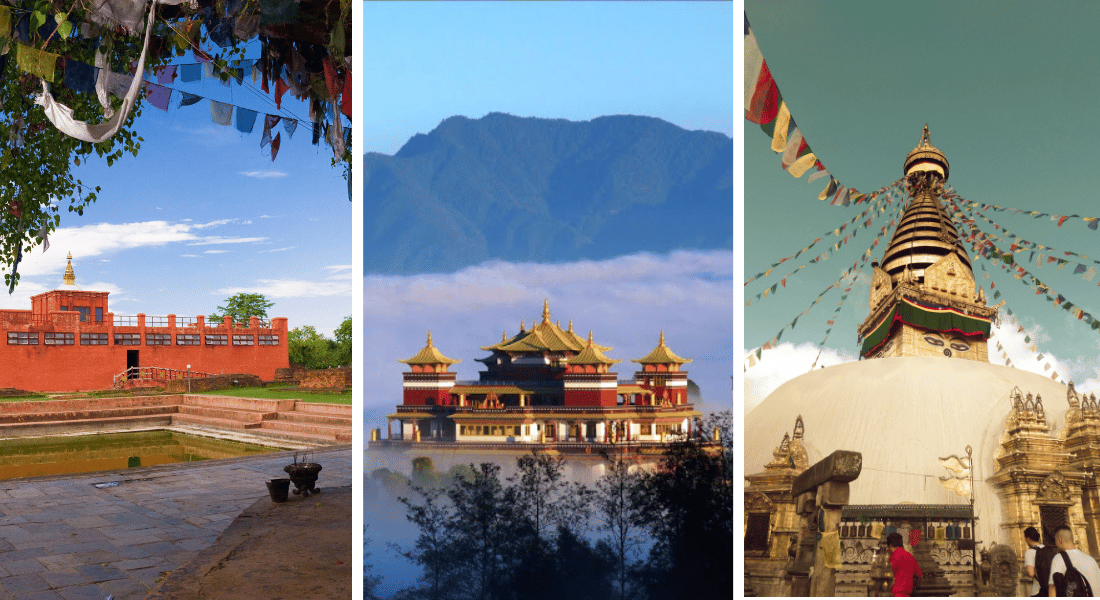Nepal, known for its high mountains and other natural beauties, is a melting pot of religions. Although Nepal is primarily a Hindu country, all religions coexist peacefully, creating a serene environment. Among its many distinctions, Nepal holds a sacred place in the hearts of Buddhists around the globe as the birthplace of Siddhartha Gautama, the Lord Buddha. As the cradle of Buddhism, Nepal is home to some of the most important pilgrimage sites that continue to attract devotees, monks, and travellers seeking peace, enlightenment, and spiritual awakening.
Nepal is a significant destination for Buddhist pilgrims, as it is the birth land of Gautam Buddha and many other important events in his life. This is an important religion in most Asian countries. From the sacred Lumbini to the grand stupas in Kathmandu Valley, it has been a popular Buddhist pilgrimage site for ages. These revered places attract thousands of Buddhist pilgrims from around the world. Devotees from Asia and beyond visit Nepal to see the pilgrimage sites with great faith. Many Buddhist religious sites located within the Kathmandu Valley are listed as world heritage sites by UNESCO.
Nepal is an important destination for Buddhist pilgrims for many reasons. The Buddhist pilgrimage sites here are the symbol of the culture and heritage of Nepal. People who are looking for Buddhist pilgrimage in Nepal, this article will be helpful to know about major Buddhist pilgrimage sites, the way to reach these sites, and some facts about these sites.
Buddhism in Nepal
Buddhism is the second major religion in Nepal, accounting for 23,93,549 individuals, which is 8.21% of the total population of Nepal. It is deeply connected with the country’s cultural and spiritual heritage. Buddhism in Nepal is said to date even before the birth of Siddhartha Gautama; however, it was popularised to the world after he became the enlightened one. Not only Shakyamuni Buddha, but there are 3 other Buddhas born in Nepal, namely the Kasyapa, Karakukchanda, and Kanakmuni, who have made a significant contribution to spreading Buddhism in Nepal.
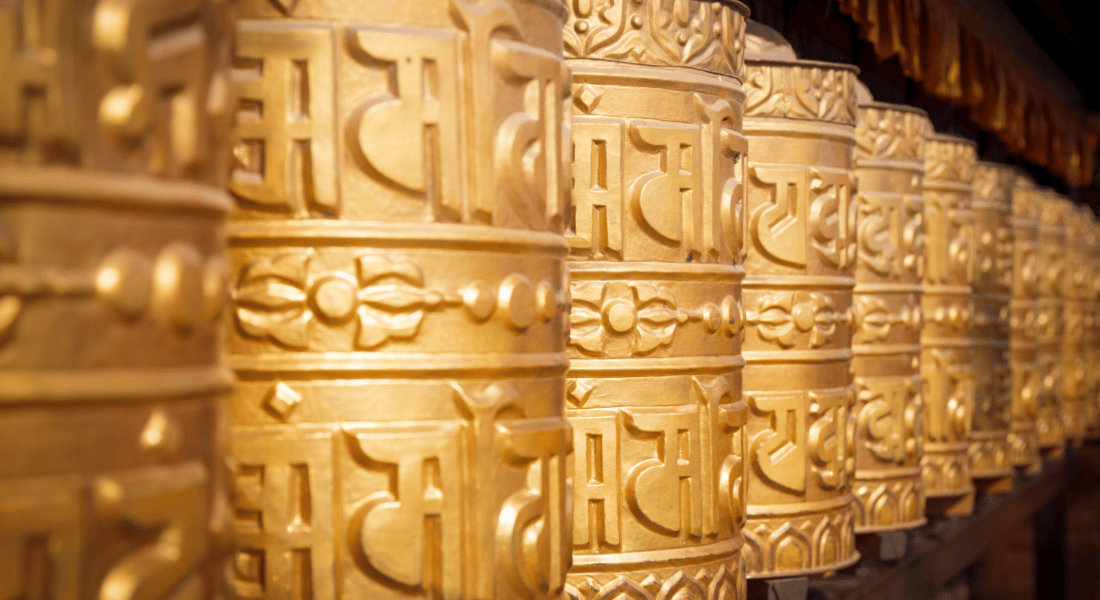
Historically, Buddhism was a popular religion in the world as well as in Nepal. Buddhism in Nepal is said to have started spreading since the reign of Ashoka through his missionaries. A significant push in Buddhism in Nepal was after the visit of the Mouryan Emperor Ashoka to Lumbini. He was a Buddhist king and practiced Buddhism during his rule. He visited Lumbini in search of the birthplace of Buddhas and erected pillars marking the birth spots of the Buddhas while also stating his presence in these holy lands.
Despite being predominantly a Hindu Kingdom, Buddhist influences are prevalent in most aspects of the culture of Nepal to the extent that Buddhist and Hindu temples are shared places of worship for people of both faiths, so that, unlike in other countries, the distinction between Hinduism and Buddhism in Nepal is not always clear. Even Gautam Buddha is considered an incarnation of Lord Vishnu. Buddhism is particularly prevalent in the northern regions or the Himalayan regions of Nepal, especially among ethics groups like Sherpa, Magar, Rai, Tamang, Gurung, and others.
List of Major Buddhist Pilgrimage Sites in Nepal
Here is the list of some of the major Buddhist pilgrimage sites in Nepal:
|
Sites |
Location |
|
Lumbini |
Rupandehi |
|
Swayambhunath Stupa |
Swayambhu, Kathmandu |
|
Boudhanath Stupa |
Boudha, Kathmandu |
|
Kopan Monastery |
Budhanilkantha, Kathmandu |
|
Namobuddha Monastery |
Simalchaur, Namo Buddha, Kavre |
|
Tilaurakot |
Kapilvastu |
|
Ramgram Stupa |
Ramgram, Parasi |
|
Milarepa Cave |
Manang |
|
Tengboche |
Khumjung, Khumbu |
|
Halesi Matrica Cave |
Halesi, Khotang |
|
Shey Gompa |
Dolpa |
|
Bajrayogini Temple |
Sankhu, Kathmandu |
|
Chungsi Cave |
Upper Mustang |
|
Ashura Cave |
Pharping |
Lumbini
Lumbini, the sacred birthplace of Lord Buddha, is located in the Rupandehi district of the mid-western region of Nepal. The place holds a deep spiritual significance in the world of Buddhism, as it is one of the 4 places where Gautam Buddha himself told his followers to visit after his Maha Parinirvana. Due to Lumbini’s high significance in the world, it was recognised as a must visit Buddhist pilgrimage site in the world and also was declared a UNESCO World Heritage Site in the year 1997.

There are several key destinations that are related to Buddha life, among which the most important and significant is the Maya Devi Temple located in the Lumbini Sacred Garden. Inside this temple there is a marker stone to recognise the exact birthspot of Gautam Buddha, an idol depicting Mayadevi giving birth, and also contains the ancient structure built by King Ashoka to protect this site during his visit. Outside the temple there are several important elements, like the Mayadevi Pond where Lord Buddha was said to have had his first bath, the remains of the Ashoka Pillar installed by King Ahsoka himself, and several other stupas containing ancient relics.
Besides the Lumbini Sacred Garden, there are other significant monasteries built by different countries that follow Buddhism. The area falls under the Master Plan of Lumbini, which was designed by renowned Japanese architect Kenzo Tange in the year 1978. The Master Plan is designed to make Lumbini a highly significant pilgrimage site for Buddhists. The master plan has been divided into 4 major parts: Sacred Garden, where Mayadevi Temple is located; West Monastic Zone, having monasteries of various countries dedicated to Mahayana Buddhism; East Monastic Zone, having monasteries of various countries dedicated to Theravada Buddhism; and New Lumbini Village, intended to serve visitors with additional services. Lumbini is not only a site of historical and archaeological importance but also a vibrant cultural hub where several major festivals like Buddha Jayanti, Losar, etc. are celebrated, attracting pilgrims and visitors from around the world.
Lumbini Facts
Here are some facts related to the Lumbini Heritage Site:
|
Heritage Site |
Lumbini |
|
Affiliation |
Buddhism |
|
Location |
Lumbini, Rupandehi |
|
UNESCO listed |
1997 AD |
|
Major Attractions |
|
|
Major Celebrations |
|
|
Opening Hours |
Open 24 hours |
|
Entry Fees |
Foreign Nationals: NPR 700 SAARC Nationals: NPR 400 Indian Nationals: NRP 80 Nepali Nationals: NRP 20 |
How to reach?
To reach Lumbini from Bhairahawa's Gautam Buddha International Airport, which is the closest airport to Lumbini (about 20 kilometres away), you have several transportation options. The easiest way is to take a taxi or hire a private car, which typically takes around 30 minutes to reach Lumbini. Shared jeeps and local buses are also available for a more budget-friendly option, though the travel time may be slightly longer due to multiple stops.
Learn More: Lumbini Nepal
Swayambhunath Stupa
Swayambhunath Stupa, located on top of a quaint hill in Kathmandu, is one of the holiest Buddhist pilgrimage sites in Nepal. This holy site holds deep significance for the people of Kathmandu as well as for other visitors alike. Locals believe its presence ensures peace and stability in the valley. Renowned often as the “Monkey Temple," it is one of the oldest religious sites in Nepal, dating back to the 5th century CE. Due to the religious and architectural significance of this site, it was declared a world heritage site in 1979 AD. The Swayambhunath has been a centre of Buddhist learning and practice for centuries and has been the site of many important events in the history of Nepal.
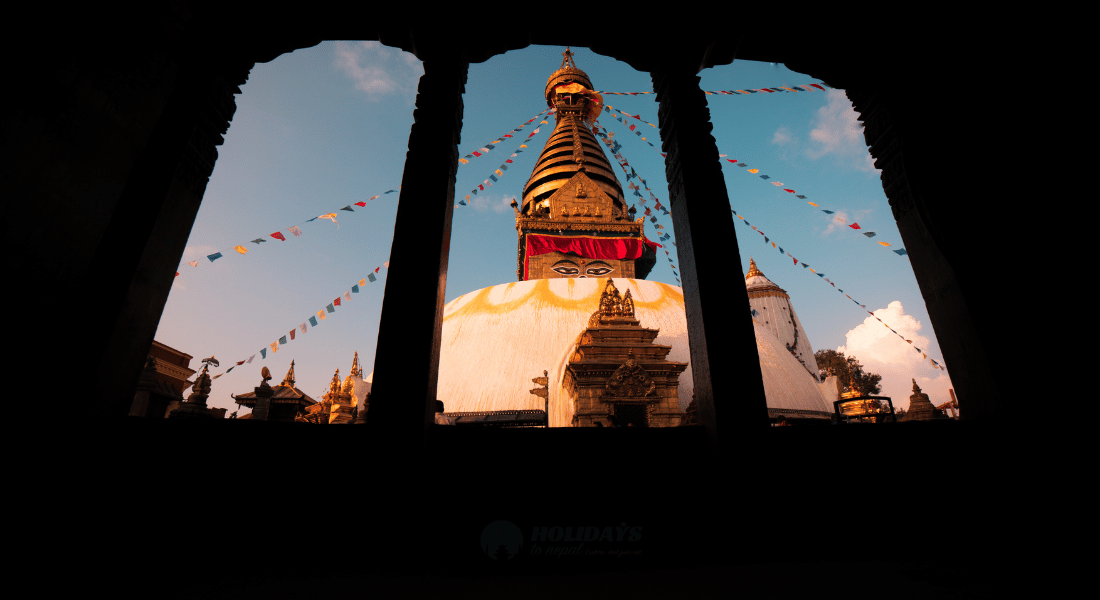
Perched on top of the Swayambhu hill, the Swayambhunath Stupa is made in a traditional dome style architecture. The stupa's dome, which symbolises the Buddha's mind, is adorned with a golden spire and features the all-seeing eyes of Buddha on all four sides, which watch over the city in all directions. Not only the Swayambhunath Stupa, but the complex itself is an important site for Buddhists of many schools and is also revered by Hindus, especially the Buddhist Newars. The attractions in the complex include the mighty Harati temple, the Ananatapur and Pratappur temples, the ritual instrument Vajra, the statue of Dipankar Buddha, the historic Dewa Dharma Monastery, the holy World Peace Pond, and many other hidden gems.
Swayambhunath Stupa’s charm is not only from its architectural marvel and its surroundings but also from it’s vibrant festivals. Since Swayambhunath is revered by both Buddhists and Hindus, different festivals celebrated by both are hosted here. One of the most significant celebrations is Buddha Jayanti, which marks the birth, enlightenment, and death of the Buddha. During this festival, the stupa is illuminated with thousands of lights, and devotees engage in extensive rituals, including offering prayers, lighting lamps, and making circumambulations. Another important festival is the Tibetan New Year, or Losar, which sees colourful processions, traditional dances, and special pujas (rituals) performed at the stupa. Additionally, the Gunla Parva, an important festival celebrated by the Newar Buddhists of the Kathmandu Valley, is celebrated with great fevour here. During this festival, the Newari Buddhists perform musical performances like they do in Jatras around the Swayambhunath Stupa area. These festivals not only enhance the spiritual atmosphere of the stupa but also highlight its role as a living centre of cultural and religious life.
Swayambhunath Stupa Facts
Here are some facts related to Swayambhunath Stupa:
|
Heritage Site |
Swaymabhunath Stupa |
|
Affiliation |
Buddhism, Hinduism |
|
Location |
Swayambhu, Kathmandu |
|
Established In |
460 AD, 13th Century (believed) |
|
UNESCO listed |
1979 AD |
|
Major Attractions |
|
|
Major Celebrations |
|
|
Architectural Style |
Dome style |
|
Opening Hours |
Open 24 hours |
|
Entry Fees |
SAARC Nationals: NPR 50 Foreign Nationals: NPR 200 (Free for Nepalese and childrens below 10 years) |
How to reach?
To reach Swayambhunath Stupa (also known as the Monkey Temple) from Kathmandu city centre (like Thamel or Durbar Square), you can take a short 10-15 minute taxi ride, which is the easiest option. For those wanting a more local experience, public buses or microbuses run along the Ring Road and can drop you near the base of the hill, from where it's a short hike up the steep stairway to the stupa.
Learn More: Swayambhunath Stupa
Boudhanath Stupa
Boudhanath Stupa, located in the Kathmandu Valley, is one of the most significant and largest stupas in the world. Believed to have been built during the 5th century, it has been an iconic symbol of Tibetan Buddhism for ages. This massive 36-metre-tall stupa is a centre piece of attraction for both locals and visitors. People participate in rituals like kora (circumambulation) around the stupa, spinning the prayer wheel. This stupa is also recognised as a UNESCO World Heritage Site and is one of the most popular tourist destinations in the country.

The Bouddhanath Stupa features a natural dome structure that houses several artefacts and ancient texts, books, and some believe even the remnants of the Kassapa Buddha. The stupa rests upon a huge mandala-shaped platform and is decorated with prayer flags. Each element of the stupa’s architecture symbolises something meaningful. The stupa is mostly composed of 3 shapes: the hemisphere, the cuboid, and the pyramid. The hemispherical dome symbolises the earthly world; the cuboid consists of the all-seeing compassionate eyes of the Buddha; and the pyramid consists of the 13 steps, symbolising stages to achieve enlightenment. The temple complex is surrounded by different monasteries, handicraft shops, and various continental as well as local eateries, making the environment lively throughout the day.
Many pilgrims visit this holy stupa seeking peace and prosperity. The complex is filled with visitors on a daily basis, but especially during festivals like Buddha Jayanti (Birth Date of Gautam Buddha) and Losars, Bouddhanath experiences a surge of pilgrims offering prayers and lighting butter lamps as a form of respect to Buddha. Bouddhanath does not only host Buddhist festivals but also Hindu festivals like the Gunla Parva, which is celebrated by the newari Buddhists. During these festivals, the Bouddhanath stupa is decorated with prayer flags and lights, making it a must-visit destination for all.
Boudhanath Stupa Facts
Here are some facts related to Boudhanath Stupa:
|
Heritage Site |
Boudhanath Stupa |
|
Affiliation |
Buddhism |
|
Location |
Bouddha, Kathmandu |
|
Architecture Style |
Dome Style |
|
UNESCO listed |
1979 AD |
|
Major Attractions |
|
|
Major Celebrations |
|
|
Opening Hours |
Open 24 hours |
|
Entry Fees |
Foreign Nationals: NPR 400 SAARC Nationals: NPR 100 |
How to reach?
Boudhanath lies about 7 kilometres north-east of central Kathmandu. To reach Boudhanath Stupa from Kathmandu city centre (Thamel area), you can take a taxi, bus, or walk part of the way. By taxi, the journey takes around 20-30 minutes, depending on traffic. Alternatively, local buses leave from Ratna Park bus station heading towards Chabahil or Boudha and are more budget-friendly but can take longer.
Learn More: Boudhanath Stupa
Kopan Monastery
Kopan Monastery, located north to the Boudhanath in the hills of Kopan, is an excellent Buddhist pilgrimage site in Nepal. The name of the monastery comes from the name of the hill it was built on. This monastery is an important centre of Tibetan Buddhism, especially for the Gelug sect in Nepal, and attracts numerous pilgrims and visitors alike from all over the world. This monastery was established by the FPMT’s (Foundation for the Preservation of the Mahayana Tradition) founders, Thubten Yeshe and Tubsten Zopa Rinpoche.

The Kopan Monastery is the biggest Gelug monastery in Nepal and is home to more than 360 monks, kamas, teachers, and workers. A large number of tourists visit this monastery, especially for meditation. Different meditation courses are offered in this monastery. The monastery offers visitors a unique opportunity to learn about Buddhism and the customs and traditions of Buddhism. The monastery is not only a place of meditation but also an attraction point for many. Different statues and small stupas with beautiful colours and paintings mesmerise visitors. The main temple features a 20 foot-tall statue of Lama Tsong Khapa, the founder of the Gelug tradition. On the left side of the sanctum is the statue of Gautam Buddha, along with other important Buddhist figures like Manjushree.
The course and spiritual atmosphere in Kopan Monastery are famous world-wide, and visitors from all over the world come to Nepal to attend these courses while enjoying the serene spiritual atmosphere of the place. Kopan Monastery provides a range of stay options that can be customised according to one's preferences. Visitors can choose to attend a course, participate in a retreat, or have a private stay for self-study or reflection in this monastery.
Kopan Monastery facts
Here are some facts about Kopan Monastery:
|
Heritage Site |
Kopan Monastery |
|
Affiliation |
Buddhism |
|
Sect |
Gelug |
|
Location |
Budhanilkantha, Kathmandu |
|
Architecture Style |
Tibetan Monastery Style |
|
Major Attractions |
|
|
Major Celebrations |
|
|
Opening Hours |
09:00 AM - 05:00 PM |
|
Entry Fees |
No entry fee for day visit |
How to reach?
To reach Kopan Monastery from Kathmandu, first, take a taxi or local bus from Thamel, the main tourist area, towards Boudhanath Stupa. This journey takes around 15-20 minutes by taxi or about 30-40 minutes by bus. From Boudhanath, hire another taxi or take a short walk to the base of Kopan Hill. From there, a 15-minute uphill walk will bring you to the monastery. Alternatively, you can take a direct taxi from Thamel or other central areas, which takes around 30-40 minutes depending on traffic. Be prepared for some narrow, winding roads as you approach the monastery.
Learn More: Kopan Monastery
Namobuddha Monastery
Namobuddha Monastery, also known as Thrangu Tashu Yangtse Monastery, is a Tibetan Buddhist monastery located south-east of Kathmandu in Kavrepalanchwok. It is a revered Buddhist pilgrimage site in Nepal and a significant centre for meditation and spiritual practice. It is considered a historical and spiritual site as this monastery is connected with the previous life of Gautam Buddha. According to the mythology, it is where Gautam Buddha in his previous life sacrificed himself to feed a starving tigress and her cubs to save their lives.
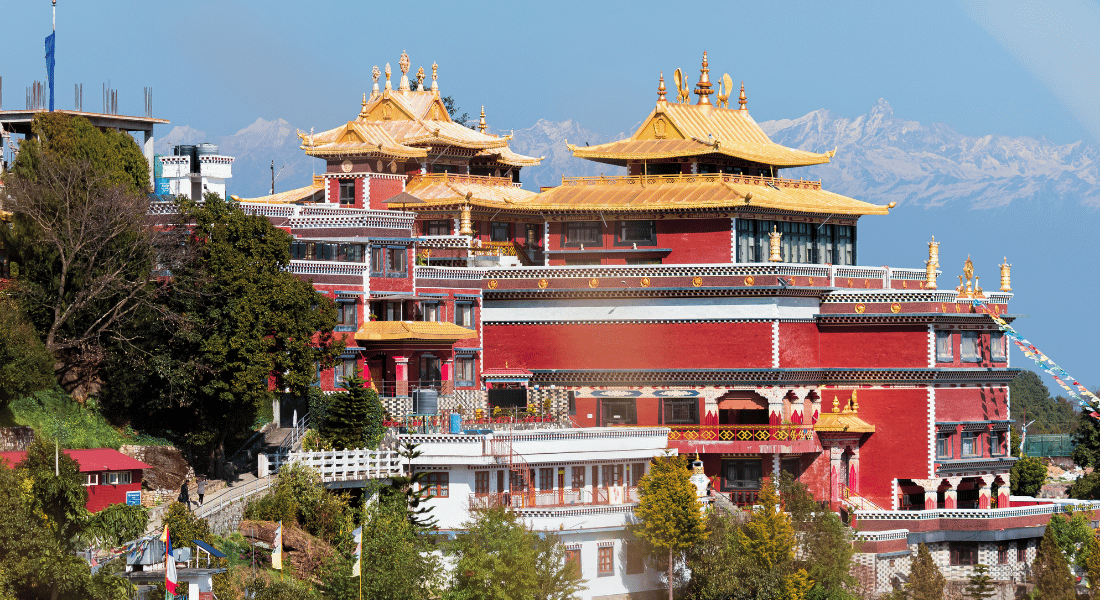
Namobuddha is not only known as a famous Buddhist pilgrimage site but also as a favourite spot for day hikers. The major attraction here is a Buddhist monastery where visitors come for meditation. They can even stay overnight with the monks if they want to see and experience their daily lifestyle. The beauty of this place is enhanced by thousands of prayer flags tied around the stupas and monasteries. The panoramic view of snowcapped mountains adds to the beauty of this place.
Additionally, the annual Buddha's Relic Festival is held to honour and venerate relics believed to be connected to the Buddha. This event attracts numerous devotees who come to witness the ceremonial display of relics, participate in elaborate processions, and engage in spiritual practices. These festivals at Namo Buddha not only enhance the spiritual atmosphere of the monastery but also strengthen the bonds within the global Buddhist community, fostering a sense of unity and shared devotion.
Namobuddha Monastery facts
Here are some facts related to Namobuddha Monastery:
|
Heritage Site |
Namobuddha Monastery (Thrangu Tashi Yangtse Monastery) |
|
Affiliation |
Buddhism |
|
Sect |
Kagyu |
|
Architecture Style |
Tibetan Monastery Style |
|
Location |
Kavre |
|
Architecture Style |
Tibetan Monastery Style |
|
Major Attractions |
|
|
Major Celebrations |
|
|
Opening Hours |
09:00 AM - 05:00 PM |
|
Entry Fees |
No entry fee |
How to reach?
To reach Namobuddha Monastery from Kathmandu city centre, you can take a local bus or private vehicle. First, head to Ratnapark or Old Bus Park in Kathmandu and catch a bus heading towards Dhulikhel, about 30 kilometres east. The bus ride to Dhulikhel takes roughly 1.5 to 2 hours, depending on traffic. From Dhulikhel, you can either hire a local taxi or walk to Namobuddha, located around 12 kilometres away. The hike takes about 3 to 4 hours and offers scenic views of the countryside, terraced fields, and local villages. Alternatively, you can drive directly from Kathmandu via Banepa to reach the monastery in about 2.5 hours.
Learn More: Namobuddha Monastery
Tilaurakot - Ancient Kapilvastu
Tilaurakot, the ancient Kapilvastu, is one of the most significant Buddhist pilgrimage sites in Nepal and is connected with the life of Shakyamuni Buddha. It is the ancient capital of the Sakya Kingdom, which was under the reign of King Suddhodana. In ancient times, this place was known as Kapilvastu and was a prosperous city. The name Tilaurakot is made up of 3 words: ‘Ti’ symbolising the 3 Buddhas born here; ‘Laura’ symbolising the 3 pillars erected by Ashoka Samrat; and ‘Kot’ meaning residence of the kings.
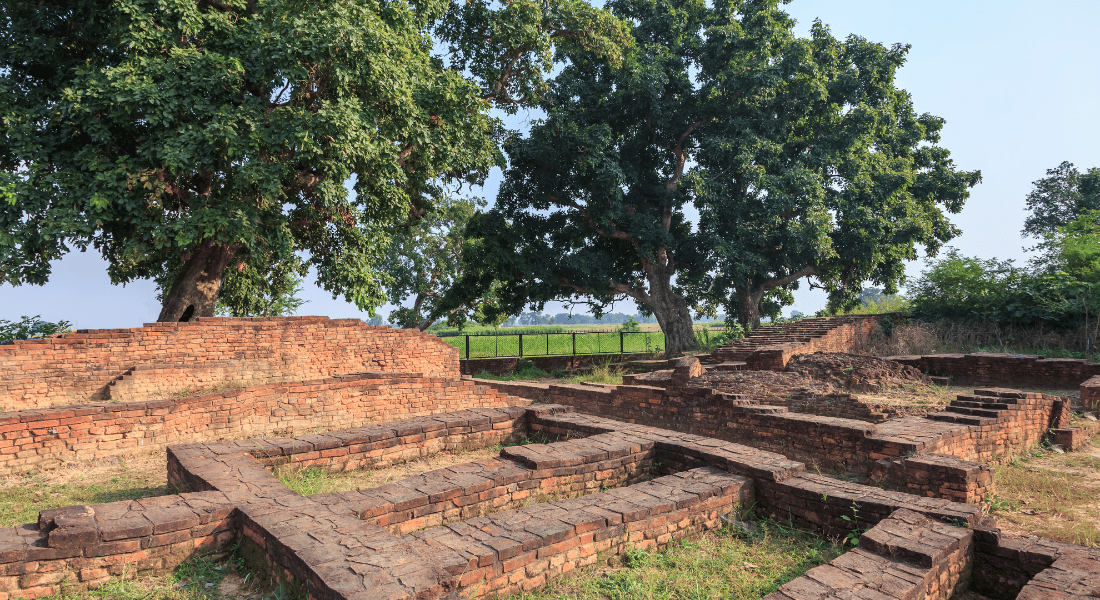
Tilaurakot is the parietal home of the Shakya Muni Buddha, where he spent 29 years of his life before leaving everything behind for finding enlightenment. This historical site houses the ancient ruins of the Shakya Kingdom, including the ruins of the palace where Siddhartha used to live. Tilaurakot is an equally significant site for Hindus as inside the ancient city walls, like the temple of Samai Mai, where traditionally devotees offer a statue of an elephant in the event of their wishes getting fulfilled. The excavation work is still being carried out, and numerous artefacts, stone sculptures, coins, etc. have been found and put in the Kapilavastu Museum, located near the Kapilvastu ancient ruin site.
Numerous pilgrims and visitors come to this place to offer their prayers and contemplate the life of the Buddha. One can get a gist of the life of Prince Siddhartha until he left everything seeking enlightenment. Nearby this site are some notable sites that pilgrims visit to pay their respect to, like the tombs of King Suddhodana and Queen Maya Devi and a stupa dedicated to the horse of Siddhartha, Kanthaka, who gave up on his life after Siddhartha left the palace to be enlightened.
Tilaurakot Facts
Here are some facts related to Tilaurakot:
|
Heritage Site |
Tilaurakot (Formerly Know- Kapilvastu) |
|
Affiliation |
Buddhism |
|
Location |
Kapilvastu |
|
Major Attractions |
|
|
Major Celebrations |
|
|
Opening Hours |
Winter Season 06:00 AM - 05:00 PM Other Season 05:30 AM - 07:30 PM |
|
Entry Fees |
No entry fee |
How to reach?
To reach Tilaurakot from Bhairahawa, start by heading west on the Siddhartha Highway from Bhairahawa. After travelling approximately 45 kilometres, you’ll arrive at the town of Tilaurakot. The route is straightforward, and you can easily hire a taxi or take a local bus for a more cost-effective option. The journey usually takes around 1 to 1.5 hours, depending on traffic and road conditions.
Ramgram Stupa
Ramgram Stupa, located in the Nawalparasi district, is one of the most sacred Buddhist pilgrimage sites in Nepal. The stupa is believed to be over 2500 years old and is considered an important site of Buddhist history and culture. Ramgram stupa is one of the 8 original stupas in the world, containing the remains of Sakyamuni Buddha. This stupa is believed to be the only stupa left untouched by the Great Emperor Ashoka in the 3rd century. This distinction has made it one of the holiest pilgrimage destinations for Buddhists from all over the world.
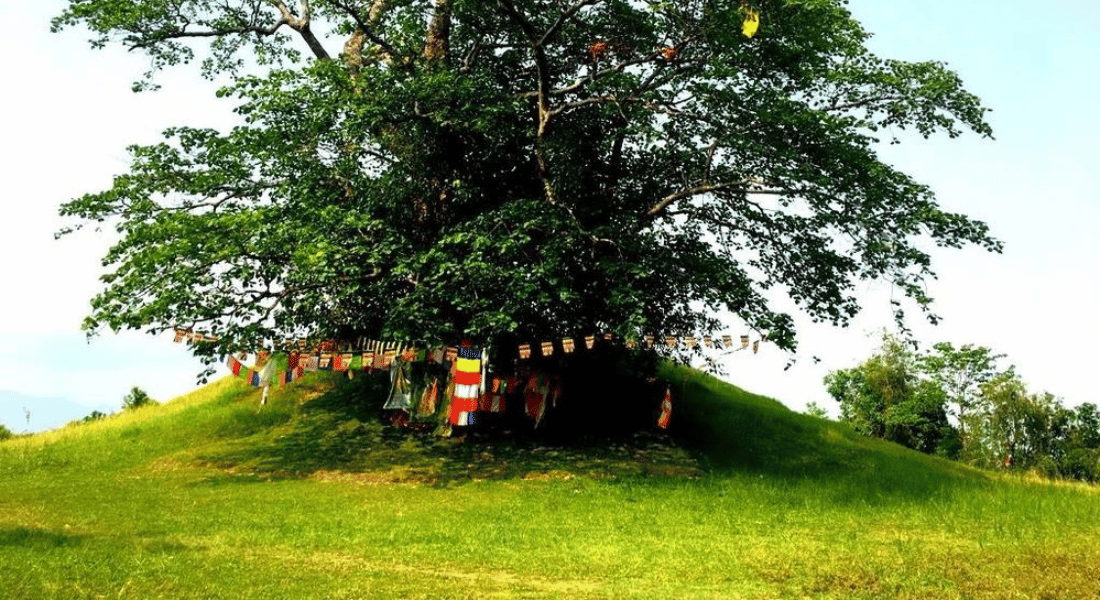
During the Buddhist Emperor Ashoka’s reign, he wanted to take out the remains of Gautam Buddha from all of the 8 original stupas and redistribute them among the 84,000 smaller stupas throughout his large empire. He was successful in obtaining relics from the 7 stupas, but not from the Ramgram stupa. It is believed that the guardian of the supa, the naga, came to Emperor Ashoka’s dream and told him not to take out Gautama Buddha's remains, which is why it was untouched.
It is believed that the Koliya king of Ramgram built the stupa in the late 3rd century. First discovered in 1899, this 7-metre tall stupa built with bricks and clay was later confirmed to be the stupa containing the relic in 1997. It’s still in the original shape, which was built by the King of Koliya. Now the stupa is covered by soli and has formed a small hill on top of which a big tree is growing out. For several years, foreigners and Nepali Buddhists have gathered at this important religious, archaeological, and historical place to worship, light incense, perform musical instruments, and sing hymns.
Ramgram Stupa Facts
Here are some facts related to Ramgram Stupa:
|
Heritage Site |
Ramgarm Stupa |
|
Affiliation |
Buddhism |
|
Location |
Ramgram, Parasi |
|
Architecture Style |
Quadrangular Kushan Style |
|
Major Attractions |
Ramgram Stupa Hill |
|
Major Celebrations |
|
|
Opening Hours |
06:00 AM - 08:00 PM |
|
Entry Fees |
No entry fee |
How to reach?
To reach the Ramgram Stupa from Bhairahawa, head west on the Siddhartha Highway, covering a distance of around 30 kilometers. The journey takes approximately 45 minutes to an hour by car or taxi. Public buses heading towards Parasi also pass near the site, though a taxi may be needed for the final stretch. Follow the highway until you reach Parasi in the Nawalparasi district, then take the local roads towards the Ramgram municipality, where the stupa is located.
Milarepa Cave
Milarepa Cave, or Milarepa Mediatation Cave, located in Braka, Manang, is situated in the lap of the Annapurna Himalayas. It was where Milarepa, the 11th century Mahayogi, meditated and practiced his austerities. Milarepa is a reknowned yogi, poet, and spiritual guru who previously committed the sin of taking people's lives by using sorcery. Later, Milarepa realised his sins and went to repent for his deeds. He became a disciple of “Marpha the Translator” after doing a lot of penance. Afterwards, he became one of the great disciples of Marpha and is one of the most famous yogis in the Tibetan Buddhist tradition of the Kagyu sect. It is also believed that Milarepa has climbed Mount Kailash.

During Milarepa’s years of meditation in the cave, he overcame many spiritual obstacles and attained self-realisation. According to a legend, a hunter named Kera Gompa Dorjee went deer hunting with his hunting dog near the cave area. Kera spotted the deer and started chasing it using his dog. Chasing for a while, the dog and the deer went inside the cave where Milarepa was meditating. After his dog didn’t come out for a long time, he decided to investigate the cave himself, armed with a bow and arrow, with caution. There he stumbled upon Yogi Milarepa along with his dog and his prey deer sitting on either side. The hunter argued with Milarepa about hunting the deer. Milarepa taught the hunter to be compassionate towards living things by singing a Buddhist song, which later became known as the “Song of the Hunter”. Visitors can still see the bow of the hunter, Kera Gompa Dorjee, hanging on a cliff.
Milarepa Cave is a popular destination for trekkers and pilgrims, at an altitude of 4100 m above sea level. This holy Buddhist pilgrimage site holds deep significance in Tibetan Buddhism as it is connected to the life of Milarepa, a prominent Tibetan Buddhist figure. This site features a small cave with a platform where Milarepa is said to have meditated and also includes a holy spring and a gompa. The cave itself is kept as a shrine by two monks, guarding a statue of Milarepa enclosed in a glass case. In the cave is an impression in the rock attributed to Milarepa's sitting meditation posture and a handprint said to have been created when Milarepa helped Rechungpa, his student, use a boulder to prop up the ceiling.
Milarepa Cave facts
Here are some facts related to Milarepa Cave:
|
Heritage Site |
Milarepa Cave |
|
Affiliation |
Buddhism |
| Sect | Kagyu |
|
Location |
Braka, Manang |
|
Architecture Style |
Naturally formed rock cave |
|
Major Attractions |
|
|
Major Celebrations |
|
|
Entry Fees |
No entry fee |
How to reach?
Milarepa Cave in Manang, Nepal, is a sacred meditation site located along the Annapurna Circuit trek. To reach it, travellers typically start from the village of Manang, which is accessible by a multi-day trek or a Jeep ride from Besisahar. From Manang, it's a half-day hike of about 5-6 hours to reach the cave, situated above the village of Braga. The trail, though steep and challenging, offers stunning views of the Annapurna range and the Marsyangdi River valley.
Tengboche Monastery
Tengboche Monastery, located at an altitude of 3867 metres in the Khumbu region of eastern Nepal, is a revered Buddhist pilgrimage sight in Nepal. This Tibetan Buddhist monastery, founded by Lama Gulu in 1916, is the largest gompa in that region. The beauty of this monastery is enhanced by the panoramic view of mountains. Mt. Everest is clearly visible from Tengboche monastery, and we can also have an amazing view of Mt. Amadablam, Lhotse, and Nuptse.

The three story monastery is built in traditional Tibetan architectural style with a spacious courtyard for monks to conduct ceremonies and other religious activities. It’s walls are adorned with intricate wood carving as well as vibrant murals depicting Buddhist deities and mandalas. The prayer hall, also known as the dokhang, contains a tall statue of Shakyamuni Buddha and smaller idols of Majurshree and Mitreya (the future Buddha) on either side. Other notable statues include the statue of Guru Padmasamva, founder of Tibetan Buddhism.
Perched on a hill at the confluence of the Dudh Koshi and Imja Khola rivers inside the Sagarmatha National Park, the Tengboche monastery is a major stop of the Everest Base Camp Trek. The Mani Rimdu festival held annually on the tenth lunar month of the Tibetan calendar, in between October and November, is a major highlight at the Tengboche Monastery. It is a vibrant celebration that serves as a spiritual focal point for the sherpa community, with monks performing masked dances. During this time of the year, many pilgrims and travellers visit this monastery to get a profound experience of the colourful festival.
Tengboche Monastery facts
Here are some facts related to Tengboche Monastery Cave:
|
Heritage Site |
Tengboche Monastery |
|
Affiliation |
Buddhism |
|
Established Date |
1916 |
|
Established By |
Lama Gulu |
|
Location |
Khumjung, Khumbu |
|
Architecture Style |
Tibetan Monastery Style |
|
Major Attractions |
|
|
Major Celebrations |
|
|
Entry Fees |
No entry fee |
How to reach?
To reach Tengboche Monastery, a popular stop along the Everest Base Camp trek in Nepal, travellers typically start their journey with a flight from Kathmandu to Lukla, a small mountain town. From Lukla, the trek begins with a hike to Phakding and then to Namche Bazaar, the largest Sherpa village and a common acclimatisation stop. From Namche, the trail continues with a moderate ascent and crosses the Dudh Koshi River before a final steep climb to Tengboche, situated at 3,867 meters. The trek to Tengboche usually takes 2-3 days, depending on pace and acclimatisation needs.
Learn More: Tengboche Monastery
Halesi Maratika Cave
Halesi Maratika Cave is an amazing Buddhist pilgrimage site in Nepal that’s definitely worth a visit if you’re into spirituality and adventure. Located in a remote part of eastern Nepal, this cave is famous for being a place where Guru Rinpoche, a revered Tibetan Buddhist master, is said to have meditated. People believe that he performed miraculous deeds here, which makes the cave a very special place for followers of Tibetan Buddhism. When you visit, you’ll find that the cave has a really mystical vibe that makes it perfect for meditation and reflection.
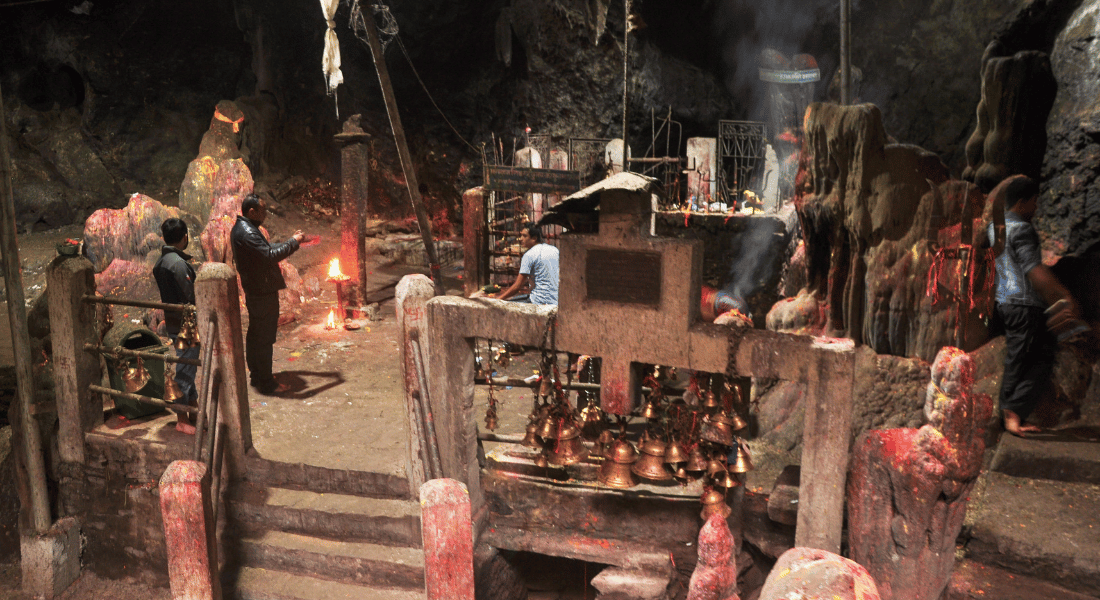
Getting to Halesi Maratika Cave is part of the adventure. You’ll need to hike through beautiful, green forests and rugged trails to reach it, which makes the journey feel even more rewarding. Once you get there, you can walk around the cave, do some rituals, and offer prayers. Inside, the cave is quiet and peaceful, with natural formations that add to the spiritual experience. Many visitors say the tranquility inside helps them feel more connected to their inner selves and the divine.
What’s cool about Halesi Maratika is that it’s not just a Buddhist site but also holds significance for Hindu pilgrims. This mix of different religious traditions highlights how the cave is a symbol of spiritual unity. Whether you’re a devoted practitioner or just curious about spiritual places, Halesi Maratika Cave offers a unique and enriching experience. It’s a place where you can enjoy nature, experience deep spirituality, and see how different faiths can come together in harmony.
Halesi Maratika Cave facts
Here are some facts related to Halesi Maratika Cave:
|
Heritage Site |
Halesi Mahadev |
|
Affiliation |
|
|
Deity |
|
|
Location |
Halesi, Khotang |
|
Major Attractions |
|
|
Major Celebrations |
|
|
Style |
Naturally Formed |
|
Opening Hours |
06:00 AM - 08:00 PM |
|
Entry Fee |
No Entry Fee |
How to reach?
To reach Halesi Maratika Cave, located in the Khotang District of eastern Nepal, travellers typically begin their journey in Kathmandu. From Kathmandu, you can take a flight to either Phaplu or Lamidanda, the nearest airports. From these airports, it's a 5 to 6-hour drive to Halesi. Alternatively, a bus or jeep ride from Kathmandu to Halesi can take about 10 to 12 hours via the BP Highway or Sindhuli Highway. After arriving in the nearby town of Halesi Bazar, it’s a short hike to the cave, which is a revered pilgrimage site for both Hindus and Buddhists, known for its spiritual and historical significance.
Related Read: Halesi Mahadev Temple
Shey Gompa
Shey Gompa, also known as Shey Monastery or Crystal Monastery, is a Tibetan Buddhist monastery located in the Shey Phoksundo National Park of the Dolpo region in Nepal. Situated at an altitude of 4360 m above sea level, the Shey Gompa is the spiritual heart of Upper Dolpa. This remote and spiritually significant site is nestled in the high-altitude desert landscape of Dolpo, an area known for its stunning natural beauty and cultural richness. Established in the 11th century by a Tibetan master, the monastery has long been a center of Buddhist learning and practice. Its isolated location and historical importance make it a key pilgrimage destination for those following the Tibetan Buddhist tradition.
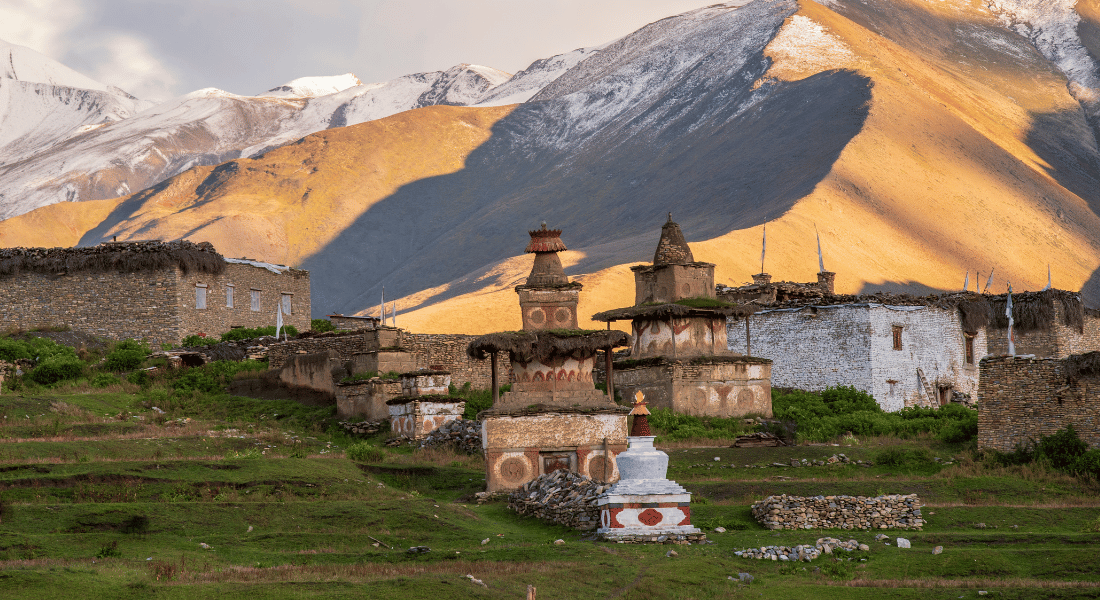
The architecture of Shey Gompa is characterised by its traditional Tibetan design, featuring intricately painted murals, colourful prayer flags, and a central assembly hall adorned with sacred statues and thangkas. The surrounding landscape, with its barren yet breathtaking beauty, complements the monastery's serene and contemplative atmosphere, offering a unique backdrop for spiritual reflection and study. The monastery is also home to a community of monks who carry out daily rituals and prayers.
One of the major attractions at Shey Gompa is the Shey Festival, which takes place every 12 years in the dragon year of the Tibetan calendar and attracts thousands of pilgrims from Nepal and Tibet. It is one of the rarest privileges to witness this festival for many people. The festival is conducted for a total of 4 days where visitors have to stay in tents near the Shey Gompa. The festival features traditional music, dance, religious rituals, and horseback riding games and is a unique opportunity to witness the rich cultural traditions of the region. The next Shey festival will be held in the year 2036.
Shey Gompa Facts
Here are some facts related to Shey Gompa:
|
Heritage Site |
Shey Gompa |
|
Affiliation |
Buddhism |
|
Established Date |
11th Century |
|
Location |
Dolpa |
|
Architecture Style |
Tibetan Stupa Style |
|
Major Attractions |
|
|
Major Celebrations |
|
|
Entry Fees |
No entry fee |
How to reach?
Shey Gompa, located in the remote Upper Dolpo region of Nepal, is accessible primarily through trekking. To reach Shey Gompa, most visitors begin their journey from Juphal, a small village with a seasonal airport connected by flights from Nepalgunj. From Juphal, trekkers typically follow a rugged trail through the villages of Dunai and Ringmo, passing by the stunning Phoksundo Lake. The trek involves crossing high-altitude passes, such as the Kang La (5,360 metres), and takes around 10 to 14 days, depending on the route and pace. Due to its isolation and challenging terrain, reaching Shey Gompa requires good physical fitness and often a special trekking permit, as the area is part of the Shey Phoksundo National Park.
Related Read: Shey Festival Trek
Bajrayogini Temple
Bajrayogini Temple is a traditional Buddhist temple located in Nepal that offers a blend of spirituality and natural beauty. Situated on a hilltop of Sankhu near the Kathmandu Valley, this temple is dedicated to Bajrayogini, or Vajrayogini, a powerful and revered female deity in Buddhism. Many people believe that Bajrayogini has the ability to grant wishes and bring protection, which makes the temple a special place for those seeking her blessings. The site is popular among both locals and tourists, who come here to pray, meditate, and enjoy the stunning views of the surrounding landscape.

To reach the temple, you’ll need to hike up a series of steps that wind through lush greenery. The path is lined with beautiful scenery and peaceful surroundings, making the hike a relaxing and enjoyable experience. Once you arrive at the temple, you’ll be greeted by its serene atmosphere and traditional architecture. The temple is adorned with colourful prayer flags and intricate carvings, adding to its spiritual charm. The temple's 3 story structure is built in traditional Nepali pagoda style with copper roof. The main shrine houses a revered statue of Bajrayogini, surrounded by colourful offerings and candles. The temple's courtyard is spacious and serene, offering panoramic views of the Kathmandu Valley and the surrounding hills. The blend of natural beauty and sacred architecture creates a tranquil atmosphere that's perfect for meditation and reflection.
At Bajrayogini Temple, visitors can participate in various rituals and festivals like the Bajrayogini Jatra, which is a famous festival celebrated by the Buddhist Newar Community in April for 8 days. During this festival, the idol of the gods from the Bajrayogini temple is taken on a procession around the town. Many people come here to make offerings, light candles, and perform circumambulations around the temple. The experience of being in this sacred space, combined with the panoramic views, makes it a memorable and uplifting visit. Whether you’re a seasoned Buddhist pilgrim or just curious about different spiritual practices, Bajrayogini Temple offers a unique opportunity to connect with Buddhism and enjoy the tranquilly of nature.
Bajrayogini Temple Facts
Here are some facts related to Bajrayogini Temple:
|
Heritage Site |
Bajrayogini Temple |
|
Deity |
Bajrayogini |
|
Affiliation |
|
|
Location |
Sankhu, Kathmandu |
|
Established By |
King Pratap Malla |
|
Architecture Style |
Nepalese Pagoda |
|
Major Attractions |
|
|
Major Celebrations |
|
|
Entry Fees |
No entry fee |
How to reach?
To reach Bajrayogini Temple, located near Sankhu, about 20 kilometres north-east of Kathmandu, Nepal, you can take a bus or taxi from the city center. The most common route is via the Araniko Highway, which passes through Bhaktapur and takes about an hour by road, depending on traffic. Once in Sankhu, you’ll need to hike uphill for about 30–45 minutes along a stone-paved path through scenic forests and terraced fields. The trek is part of the spiritual experience, offering beautiful views as you approach the historic temple dedicated to the goddess Bajrayogini.
Ranchung Chungsi Cave
Ranchung Chungsi Cave, or simply Ranchung Cave, is a popular Buddhist pilgrimage site in Mustang, which lies in between Samar and Syangboche village. Situated at an altitude of 3700 metres above sea level, it is believed that Guru Rinpoche meditated in this cave around the 8th century. This cave has a unique blend of natural beauty, historical significance, and spiritual aura that attracts pilgrims and visitors alike. This cave is also equally significant for Hindus, as it is believed that Lord Shiva meditated here while travelling to Mt. Kailash.

Chungsi Cave is a natural wonder and a well-known attraction of Mustang. Inside the cave there are different man-made structures like small stupas, prayer wheels, and paintings of various Buddhist deities like Gautam Buddha, Guru Rinpoche, and others. There is also a small living space made for the lama who lives there and also for storage of payer items. The cave is lit by natural light that filters On the walls of the Rangchung Cave there are many naturally formed deities. Many Buddhist pilgrims visit this revered cave to worship and meditate from all around the world. Surrounding nature, astounding landscapes, and man-made caves are the major attractions around this cave.
Ranchung Chungsi Cave Facts
Here are some facts related to Ranchung Chungsi Cave:
|
Heritage Site |
Ranchung Chungsi Cave |
|
Affiliation |
|
|
Location |
Mustang |
|
Architecture Style |
Naturally formed |
|
Major Attractions |
|
|
Major Celebrations |
|
|
Entry Fees |
No entry fee |
How to reach?
Chungsi Cave is located in the Mustang region of Nepal, along the popular Annapurna Circuit trekking route. To reach the cave, you typically start from Kagbeni and trek towards the village of Chuksang. The path is scenic but steep, involving a significant ascent along the Kali Gandaki River. After crossing the river and trekking up for about two hours, you'll find Chungsi Cave perched on a hillside. The journey can be challenging but offers stunning views of the Mustang valley and surrounding peaks.
Ashura Cave
Asura Cave is a fascinating and spiritually significant site located in the serene hills of Pharping, just outside Kathmandu Valley in Nepal. It holds a special place in Buddhist traditions due to its association with the revered saint, Guru Padmasambhava. According to local legend, Guru Padmasambhava, also known as Guru Rinpoche, visited this cave and used his spiritual powers to subdue the demons that once inhabited the area. These demons were transformed into protectors of Buddhism, which is why the cave is considered a place of great spiritual power. The name "Asura" comes from the Sanskrit word for demons, highlighting its historical and mythological importance.
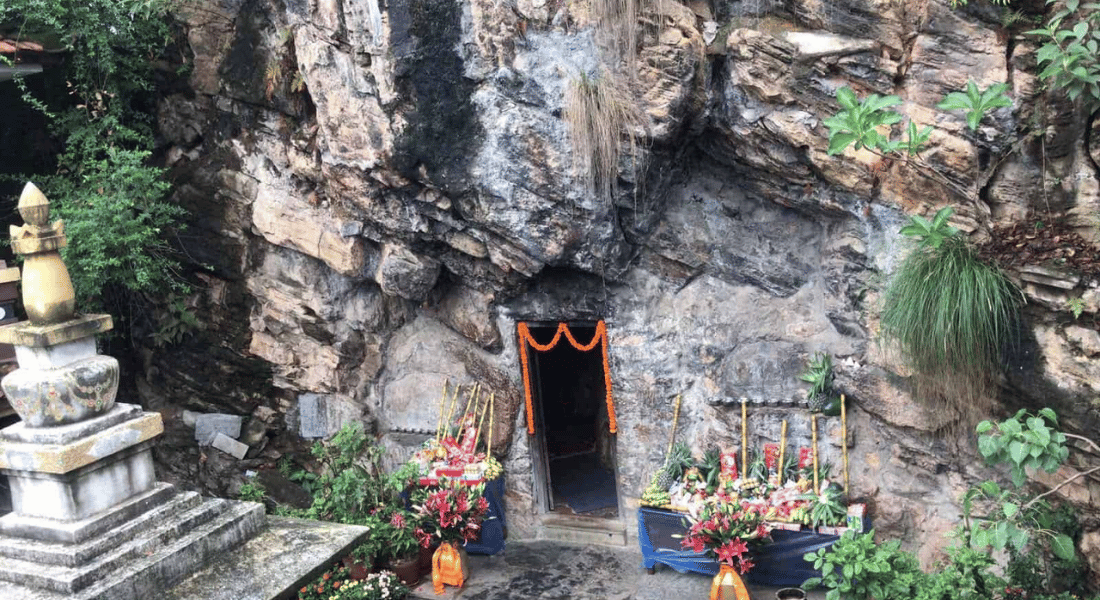
To reach Asura Cave, visitors must embark on a short but pleasant hike from the main road. The cave itself is modest in size but richly adorned with colourful prayer flags and small Buddha statues, creating a vibrant and spiritual atmosphere. Inside the cave, there is an image of Guru Padmasambhava, and many people come here to meditate, pray, and offer their respect. The natural beauty surrounding the cave adds to its allure; it offers stunning views of the valley below and the majestic snow-capped peaks of the Himalayas in the distance. Besides enjoying the scenic views, visitors can participate in spiritual practices and local ceremonies, making it a peaceful and meaningful destination for those seeking both spiritual connection and natural beauty.
Ashura Cave Facts
Here are some facts related to Ashura Cave:
|
Heritage Site |
Ashura Cave |
|
Affiliation |
Buddhism |
|
Location |
Pharping, Kathmandu |
|
Architecture Style |
Naturally formed |
|
Major Attractions |
|
|
Major Celebrations |
|
|
Entry Fees |
No entry fee |
How to reach?
To reach Ashura Cave in Pharping, begin your journey by travelling to Pharping from Kathmandu, either by taxi, which takes about 1-2 hours, or by local bus from Ratna Park, which takes around 2-3 hours. Once in Pharping, follow the paved road to the right, leading uphill through the village. As you walk up, you’ll pass notable landmarks such as Kyapjé Tulku Urgyen Rinpoche's monastery, Sakya Tharig Monastery, Ralo Rinpoche’s Monastery, and Tara shrine leading to the Ashura Cave.
Travel tips for Buddhist pilgrims in Nepal
Travelling to Nepal as a Buddhist pilgrim can be a deeply enriching experience. To make the most of your pilgrimage, here are some helpful tips:
Plan Ahead and Learn Local Customs
Before you set off, research the specific pilgrimage sites you wish to visit, such as Lumbini, the birthplace of Buddha, or the sacred caves like Halesi Maratika and Chungsi Cave. Understanding the local customs and religious practices will help you show respect and participate meaningfully in rituals. For example, knowing how to perform circumambulation correctly or how to make offerings will enhance your experience.
Prepare for Varying Terrain and Weather
Nepal's pilgrimage sites are often in remote or mountainous areas, so be ready for diverse terrain. Bring sturdy hiking shoes, weather-appropriate clothing, and a good quality backpack. Weather can change quickly in the mountains, so packing layers and waterproof gear is essential. Also, make sure to stay hydrated and carry some snacks for long treks.
Respect Local culture and Etiquette
While in Nepal, embrace the local culture and traditions. Learn a few basic Nepali phrases, which can be helpful and appreciated. Always remove your shoes before entering religious sites, and dress modestly—covering your shoulders and knees. When interacting with monks or local devotees, be polite and respectful, and follow their lead in ceremonies and practices.
Accommodations and Health Precautions
Choose accommodations that align with your pilgrimage needs, whether it’s a basic guesthouse or a monastery stay. Be aware of health precautions, including vaccinations and food hygiene, to avoid common travel illnesses. Carry a basic medical kit with essential medications and first-aid supplies.
Stay Mindful and Flexible
Pilgrimages are about spiritual journeys, so stay mindful of your inner experience as well as your surroundings. Be flexible with your plans, as travel in Nepal can be unpredictable. Embrace the unexpected as part of your spiritual path, and maintain an open heart and patience throughout your journey.
By preparing well and approaching your pilgrimage with respect and openness, you’ll be able to fully immerse yourself in the profound spiritual experience that Nepal offers.
Conclusion
Nepal stands as a profound destination for Buddhist pilgrims, offering a wealth of sacred sites that span the country’s rich spiritual landscape. From the revered birthplace of Buddha at Lumbini to the tranquil retreats of Namobuddha Monastery and Shey Gompa, each location provides a unique opportunity for reflection and growth. The journey through these sites—whether it’s the bustling energy of Swayambhunath Stupa, the serene atmosphere of Milarepa Cave, or the remote beauty of Ashura Cave—promises a deeply enriching experience.
Travelling to these sites involves a mix of transportation methods, including flights, road trips, and sometimes challenging treks. Planning your route and understanding the logistics can enhance your pilgrimage experience, ensuring you reach each sacred spot with ease and reverence. Local guides and organised tours can provide valuable assistance, especially for navigating the more remote areas.
Visiting Nepal for a Buddhist pilgrimage is not only a journey through sacred geography but also a deep dive into a living tradition that continues to inspire and uplift. The spiritual essence of each site, coupled with the breathtaking natural beauty of Nepal, creates a transformative experience for all who seek it. Embrace the opportunity to explore these spiritual treasures and let Nepal’s rich heritage guide you on a path of inner discovery and peace.

